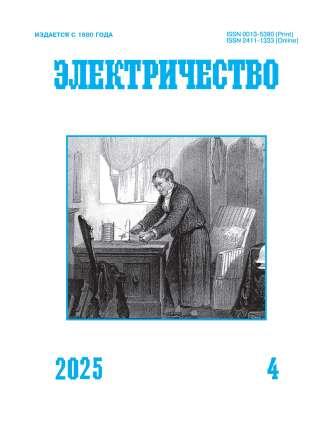Determination of Transistor Losses in a Resonant Voltage Inverter
DOI:
https://doi.org/10.24160/0013-5380-2025-4-44-52Keywords:
inverter, power loss, inductive detuning, capacitive detuning, resonance frequency, simulation, field effect transistor, turn-on timeAbstract
The article addresses experimental studies of losses in a resonant inverter during its operation with different detuning degrees. The study is prompted by the increasingly growing need to achieve more efficient operation of powerful energy converters and improve the characteristics of power electronics products in terms of increasing conversion operating frequencies, reducing power losses in power components, and reducing dynamic overloads. Resonant voltage inverters are one of the most energy-efficient types of converters. In many cases however, numerical simulation does not demonstrate a radical difference in energy efficiency when the converter operates with different degrees of its detuning, which can cause the converter failure. The results of experimental studies are compared with the relevant data predicted using standard transistor models. A test laboratory bench has been assembled to determine the dependence of power loss in the resonant inverter transistors on frequency. A computer Spice model of a resonant inverter has been developed to explain the differences in losses depending on the detuning degree. The simulation results demonstrate that the dependence of transistor cell power loss on the frequency is not very strong with deviation from the resonance frequency, and do not show that it has such a significant effect. The conducted study makes it possible to see a somewhat approximate distribution of losses depending on the detuning type and draw a conclusion that the models of semiconductor shall undergo verification.
References
2. Головин А.Н. Методика расчета и оптимизации процессов переключения транзисторов в резонансном инверторе тока. – Научно-технические ведомости СПбГПУ, 2010, № 2, с. 58–65.
3. Васильев, А.С., Конрад Г., Дзлиев С.В. Источники питания высокочастотных электротермических установок: монография. Т. 4. Новосибирск: Изд-во НГТУ, 2006, 426 с.
4. Дзлиев С.В. Транзисторные генераторы для индукционного нагрева. СПб.: Изд-во СПбГЭТУ «ЛЭТИ», 2012, 143 с.
5. Бондаренко Д.Н., Дзлиев С.В., Патанов Д.А. Коммутационные процессы в транзисторных инверторах для индукционного нагрева. – Известия ГЭТУ, 1996, вып. 497, с. 98–110.
6. Опре В.М., Дозоров С. Сравнительный анализ электромагнитных процессов в однофазных индуктивно-емкостных преобразователях. – Силовая электроника, 2013, № 3, с. 59–62.
7. Анучин А.С. и др. Минимизация и перераспределение коммутационных потерь в инверторе напряжения при использовании алгоритма широтно-импульсной модуляции с прогнозированием. – вестник московского энергетического института, 2019, №1, с. 79–85.
8. 1200 V CoolSiC™ MOSFET: Trench Technology Essentials. Munich, Germany: Infineon Technologies AG, 2024, 29 p.
9. Comparison of SiC MOSFET and Si IGBT. Toshiba Electronic Devices & Storage Corporation, 2020, 10 p.
10. Abdel-Rahman S., Stückler F., Siu K. PFC Boost Converter Design Guide. Munich, Germany: Infineon Technologies AG, 2014, 30 p.
11. Bououd M. Mitigating Reverse Recovery Power Losses in MOSFET Switching Cell Using Extra Schottky Diodes – Application to Voltage Source Inverter. – Power Electronic Devices and Components, 2024, No. 8, DOI: 10.1016/j.pedc.2024.100066.
12. Тихомиров И.С., Патанов Д.А. Определение оптимального тока коммутации транзисторов инвертора напряжения в установках индукционного нагрева. – Журнал научных публикаций аспирантов и докторантов, 2008, № 3, с. 188–192.
13. Geetha K., Sreenivasappa B.V. Power Loss Calculation for IGBT and SiC MOSFET. – Journal of Xi'an University of Architecture & Technology, 2020, pp. 378–382, DOI: 10.37896/JXAT12.08/2637.
14. Lakkas G. MOSFET Power Losses and how They Affect Power-Supply Efficiency. – Analog Applications Journal: Enterprise Systems, 2016, pp. 22–26.
15. Воронин П.А. Силовые полупроводниковые ключи: семейства, характеристики, применение. М.: ДМК Пресс, 2015, 382 с.
#
1. Jiang C. et al. An Overview of Resonant Circuits for Wireless Power Transfer. – Energies, 2017, vol. 10, iss. 7, DOI: 10.3390/en10070894.
2. Golovin A.N. Nauchno-tehnicheskie vedomosti SPbGPU – in Russ. (Scientific and Technical Bulletin SPbPU), 2010, No. 2, pp. 58–65.
3. Vasil’ev A.S., Konrad G., Dzliev S.V. Istochniki pitaniya vysokochastotnyh elektrotermicheskih ustanovok (Power Supplies for High-Frequency Electrothermal Installations). Vol. 4. Novosibirsk: Izd-vo NGTU, 2006, 426 p.
4. Dzliev S.V. Tranzistornye generatory dlya induktsionnogo nagreva (Transistor Generators for Induction Heating). SPb.: Izd-vo SPbGETU «LETI», 2012, 143 p.
5. Bondarenko D.N., Dzliev S.V., Patanov D.A. Izvestiya GETU – in Russ. (Proceedings of the State Electrotechnical University), 1996, iss. 497, pp. 98–110.
6. Opre V.M., Dozorov S. Silovaya elektronika – in Russ. (Power Electronics), 2013, No. 3, pp. 59–62.
7. Anuchin A.S. et al. Vestnik MEI – in Russ.(Bulletin of the MPEI), 2019, No. 1, pp. 79–85.
8. 1200 V CoolSiC™ MOSFET: Trench Technology Essentials. Munich, Germany: Infineon Technologies AG, 2024, 29 p.
9. Comparison of SiC MOSFET and Si IGBT. Toshiba Electronic Devices & Storage Corporation, 2020, 10 p.
10. Abdel-Rahman S., Stückler F., Siu K. PFC Boost Converter Design Guide. Munich, Germany: Infineon Technologies AG, 2014, 30 p.
11. Bououd M. Mitigating Reverse Recovery Power Losses in MOSFET Switching Cell Using Extra Schottky Diodes – Application to Voltage Source Inverter. – Power Electronic Devices and Components, 2024, No. 8, DOI: 10.1016/j.pedc.2024.100066.
12. Tihomirov I.S., Patanov D.A. Zhurnal nauchnyh publikatsiy aspirantov i doktorantov – in Russ. (Journal of Scientific Publications of Postgraduate and Doctoral Students), 2008, No. 3, pp. 188–192.
13. Geetha K., Sreenivasappa B.V. Power Loss Calculation for IGBT and SiC MOSFET. – Journal of Xi'an University of Architecture & Technology, 2020, pp. 378–382, DOI: 10.37896/JXAT12.08/2637.
14. Lakkas G. MOSFET Power Losses and how They Affect Power-Supply Efficiency. – Analog Applications Journal: Enterprise Systems, 2016, pp. 22–26.
15. Voronin P.A. Silovye poluprovodnikovye klyuchi: semeystva, harakteristiki, primenenie (Power Semiconductor Switches: Families, Characteristics, Applications). M.: DMK Press, 2015, 382 p




